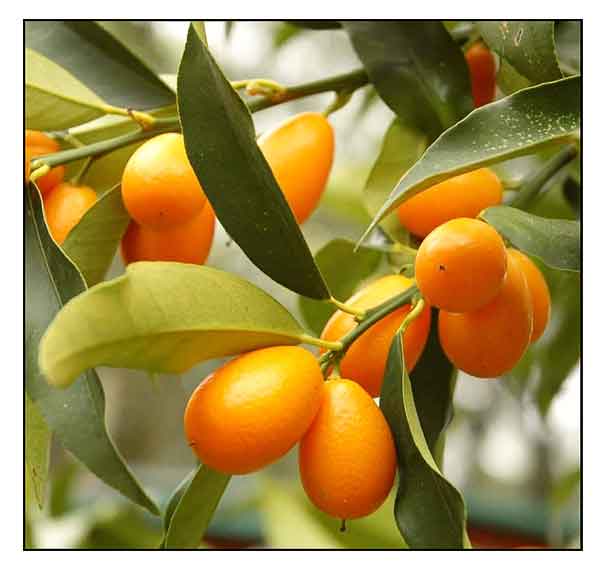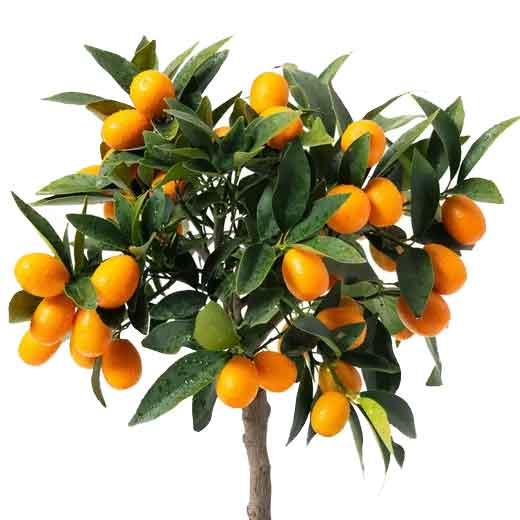 Gen info Gen info
- Kumquats are a small group of small fruit-bearing trees in the flowering plant family Rutaceae.
-
The kumquat plant is native to southern China. Historical reference to kumquats appeared in literature as early as the 12th century. It has been long cultivated in parts of East Asia (Japan), South Asia (India), and Southeast Asia (especially the Philippines). (3)
- Taxon conflicts: Kumquats have traveled in taxonomy conflict—previously classified in the now-historical genus Fortunella; placed within Citrus, sensu lato; assigned as a single species, C. japonica; to numerous cultivar species.
- Recent genomic analysis have defined three pure species: Citrus hindsii, C. margarita, and C. crassifolia, with Citrus x japonica being a hybrid of the last two.
(3)
- However, the Citrus taxonomy is complicated and continues to be controversial. Different systems place various types of kumquat into different species or unite them into as few as two species Varieties are often classified as their own species, rather than as cultivars.
A recent genomic analysis concluded there was only one true species of kumquat, but he analysis did not include the Hong Kong variety considered a distinct species in all previous analysis.
(3)
-
The English name Kumquats is derived from the Cantonese gam gat, meaning "gold" and "luck".The plant is considered a symbol of wealth and prosperity. C. japonica 'Fukushu' is the most popular cultivar used for the Chinese New Year festival. (5)
- Two main kinds of kumquat reported in the Philippines are Fortunella margarita and Fortunella japonica.
 Botany Botany
Citrus japonica is a tree to 5 m tall, d.b.h. to 20 cm. Branchlets numerous; spines variable, to 5 cm on young growth but some only a few mm on flowering shoots. Leaves 1-foliolate or sometimes mixed with simple leaves; petiole 6-9 mm, narrowly winged; leaf blade elliptic to obovate-elliptic, 4-6 × 1.5-3 cm, base rounded to broadly cuneate, margin dentate near apex or rarely entire, apex rounded and rarely mucronate. Flowers solitary or fascicled, subsessile. Calyx 4- or 5-lobed. Petals 5, ca. 5 mm or less. Stamens ca. 20; filaments cohering into 4 or 5 bundles. Ovary as long as style, 3- or 4-loculed, with 3 or 4 ovules per locule. Fruit bright orange to red, globose to slightly oblate, 9-10 mm in diam., smooth, 3- or 4-seeded; pericarp sweet and edible; sarcocarp acidic. Seeds broadly ovoid, apex mucronate; seed coat smooth; embryos at least sometimes numerous; cotyledons green. (Flora of China)
Citrus japonica is a small compact tree, it can grow up to 5m tall. Leaves are arranged alternately along the stem and are lanceolate in shape with a dentate leaf margin. Flowers are 5-petalled, white and fragrant and are borne in clusters or as a single flower. Fruit is small in size and ranges in shape from globose, obovate, round to oblong, turning to orange when ripe, sweet and acidic to taste. (5)
Distribution
- Introduced.
- Cultivated.
- Native to southeast China, Hainan.
 Constituents Constituents
- Hydrodistillation and GC-MS study of C. japonica leaves for essential oil identified 42 compounds, accounting for 99.6% of the oil. Major components were linalool (35.1%), eugenol (14.8%), geraniol (12.7%), and its aldehyde counterpart geranial (7.9%), with smaller amounts of nerol (5.3%), and (Z)-asarone (5.0%). (6)
- Seven flavonoids from hot water extract of immature kumquat were identified and quantified (mg/100 g fresh fruit): 3′,5′-di-C-β-glucopyranosylphloretin (DGPP, 285.9 ± 2.9 mg/100 g), acacetin 8-C-neohesperidoside (margaritene, 136.2 ± 2.6 mg/100 g), acacetin 6-C-neohesperidoside (isomargaritene, 119.1 ± 1.8 mg/100 g), fortunellin (acacetin 7-O-neohesperidoside, 28.5 ± 0.7 mg/100 g), apigenin 8-C-neohesperidoside (16.9 ± 0.1 mg/100 g), poncirin (isosakuranetin 7-O-neohesperidoside, 5.1 ± 0.1 mg/100 g), and rhoifolin (apigenin 7-O-neohesperidoside, 2.0 ± 0.1 mg/100 g). (see study below) (9)
- Nutrient analysis of 100 g portion of raw kumquats: water 80.8 g, energy 71 kcal, protein 1.88 g, total lipid (fat) 0.86 g, ash 052 g, carbohydrate by differ 15.9 g, total dietary fiber 6.5 g, sugars (total, including NLEA) 9.36 g, calcium 62 mg, iron 0.86 mg, magnesium 20 mg, phosphorus 19 mg, potassium 186 mg, sodium 10 mg, zinc 0.17 mg, copper 0.095 mg, manganese 0.135 mg, vitamin C 43.9 mg, thiamin 0.037 mg, riboflavin 0.09 mg, niacin 0.429 mg, pantothenic acid 0.208 mg, vitamin B6 0.036 mg, folate (total) 17 µg, folate (food) 17 µg, folate (DFE) 17 µg, choline (total) 8.4 mg, vitamin B12 0, vitamin A (RAE) 15 µg, lutein + zeaxanthin 129 µg, vitamin E (alpha tocopherol) 0.15 mg, saturated fatty acids 0.103 g, total monounsaturated fatty acids 0.154 g, total polyunsaturated fatty acids 0.171 g, fatty acids (total trans) 0, cholesterol 0.
Properties
- Studies have suggest antioxidant, anti-inflammatory, antimicrobial, hypoglycemic, hypotriglyceridemic, anticancer, antiproliferative properties.
Parts used
Fruit, leaves, oil.
Uses
Edibility
- Fruit are edible; eaten raw as a sweet-tart snake, or added to salads, candied, sliced and added to desserts and drinks, or used as garnish, or pureed or juiced.
Folkloric
- Ayta communities in Dinalupihan, Bataan, drink the fruit juice or eat grilled fruits with honey to relieve cough and phlegm.
-
Decoction of fruit and leaves used for treatment of cough, as antiphlogistic and laxative.
Studies
• Antioxidant / Essential Oil / Peel and Kernel: GC and GC/MS study analyzed the constituents of essential oil and organic extracts of peel and kernels of C. japonica. EO content in peel and Kernel was 1.1 and 0.8% based of dry weight. The essential oil of peel and kernel was characterized by higher amount of limonene (51.0 and 47.1%) and germacrene D (12.1 and 6.3%, while the hexane extracts showed higher amounts of dodecanol-1 (12.9 and 20.8%) and linolenic acid (13.1 and 16.3%) respectively. On DPPH assay, both oils showed considerable antioxidant activity. (7)
• Effect of Drying on Flavonoids and Antioxidant Activity
/ Immature Kumquat: Study identified seven flavonoids in a hot water extract of immature kumquat (C. japonic var. margarita). When immature kumquat was dried at 110 and 130°C for 0.5h, the antioxidant activity, total phenolic and identified flavonoids increased. Results suggest that drying below 130°C for 1.0h could release phenolic compounds and enhance antioxidant activity. Drying at 130°C for 1.5 h could increase browning products and antioxidant activity. (9)
• Antimicrobial / Anti-Inflammatory / Essential Oils: Study evaluated the essential oils of citrus species F. japonica var margarita (FJE) and Citrus sunki (CSE) for anti-inflammatory and antimicrobial activity against skin pathogens i.e., Staphylococcus epidermis, Propionibacterium acnes, Malassezia furfur, and Candida albicans. Both FJE and CSE exhibited strong antimicrobial activity against most of the pathogenic bacteria and yeast strains tested. Both reduced lipopolysaccharide (LPS)-induced secretion of nitric oxide (NO) in RAW 264.7 cells, indication anti-inflammatory effects. GC-MS analysis of FJE identified dl-limonene (61.58%) and carvone (6.36%) as major components. Results suggest potential for skin applications. (10)
• Odor Components of Peel Oil: Study evaluated the composition of kumquat (Fortunella japonica Swingle) cold-pressed peel oil and determined the volatile compounds primarily responsible for the aroma of the oil. GC and GC-MS identified 82 compounds in the oil. Major compounds were limonene (93.73%), myrcene 1,84%), and ethyl acetate (1.13%). Citronellyl formate and citronellyl acetate were regarded as the characteristic odor components of kumquat peel oil. (11)
• Effect of Serum Triglyceride Level / Peel: Study evaluated the effect of giving butanol fraction and ethyl acetate fraction of kasturi citrus peel (Citrus japonica Thunb.) on triglyceride levels of male white rats (Rattus norvegicus). At doses of 250 mg/kbw, there was a significant decrease in triglyceride levels (p<0.05) compared to control and a decrease that showed not significant difference (p>0.05) to atorvastatin. There was not difference between the antihyperglycemmic activity of the butanol fraction and ethyl acetate fraction. (p>0.05). (12)
• Hypoglycemic / Antioxidant / Thyroid Benefit / Whole Kumquat: Study evaluated the chemical composition, antioxidant activity, and hypoglycemic effects of whole kumquat (ku) powder in diabetic rats fed a high-fat-high-cholesterol (HFHC) diet. Total phenolic content was 51.85 mg gallic acid GAE/g and total flavonoid content was 0.24 mg catechin equivalent CE/g. DPPH and ABTS values were 3.32 and 3.98 mg Trolox equivalent (TE)/g, FRAP was 3.00 mM Fe2+ dry material. Diets supplemented with Kumquat at different concentrations showed hypoglycemic effect and improved the thyroid hormones of both diabetic and HFHC diabetic rats. (13)
• Antiproliferative on Human Cancer Cell Lines / Essential Oil: Study evaluated the effects of kumquat essential oil on the proliferation of three human cell lines (HT-1080 fibrosarcoma cells, HeLa cervical adenocarcinoma cells, and CUA-4 normal human fibroblasts). As concentration of kumquat EO increased, cell proliferation and viability, as measured by MTT assays, decreased in all three cell lines. HT-1080 cells exposed to kumquat EO exhibited increased phosphorylated JNK. Apoptosis was also stimulated. EO constituents limonene and myrcene both independently led to decreased proliferation and apoptosis. (15)
• Inhibition of Prostate Cancer Cell Proliferation / Volatile Oil: Hydrodistillation and GC-MS study of fresh Nagama kumquats (Fortunella margarita) yielded a total of 25 volatile compounds. Major compounds were d-limonene (41.64%), ß-myrcene (16.54%), linalyl propionate (9.55%), and germacrene-D (5.93%). Oil was rich in hydrocarbons (77.41%) consisting of 60.05% monoterpenes and 17.36% sesquiterpenes. The kumquat volatile oil at 200 ppm concentration exhibited 55%, 61%, and 63.4% inhibition of prostate cancer (LNCaP) cell proliferation at 24, 48, and 72 h, respectively by cell count assays. Cleavage of caspase-8 in LNCaP cells treated with volatile oil demonstrated that apoptosis occurred through the extrinsic pathway. This is the first report on the possible antiproliferative mechanisms of kumquat volatile oil components on human prostate cancer cells. (16)
Availability
Cultivated.
Seeds, tea, supplements in the cybermarket.
|

![]()






